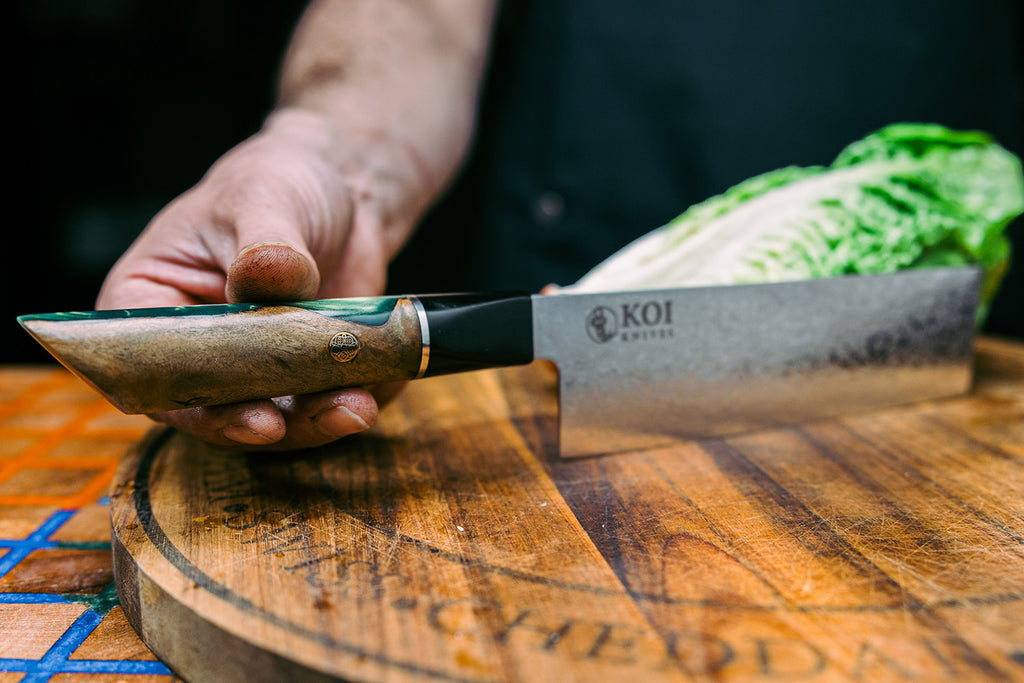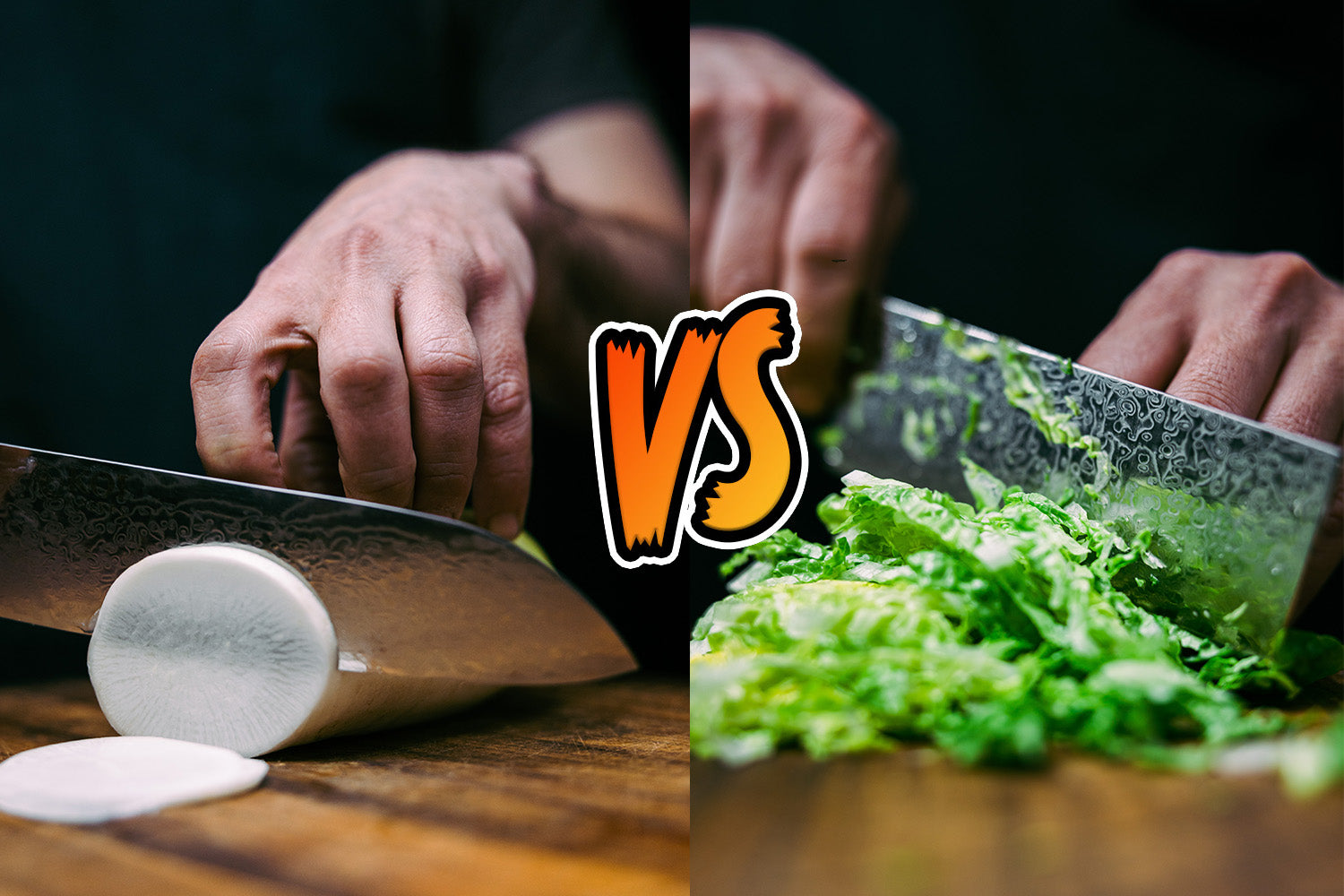In the world of Japanese chef knives, there are two shapes that often cause confusion: Santoku and Nakiri. While they may look similar at first glance, these two knives actually have very different uses.
The Santoku is an all-purpose and most widely used knife thats perfect for slicing, dicing, and mincing. In contrast, the Nakiri is designed specifically for chopping vegetables. Ultimately, it comes down to personal preference when deciding between a santoku and Nakiri knife. We will take a look at the differences between Santoku and Nakiri knives and help you decide which one is best for you.
What is a Santoku Knife?
A Santoku knife is a Japanese all-purpose kitchen knife. The word "Santoku" means "three virtues" or "three uses," which refers to the three cutting tasks it excels at: slicing, dicing, and mincing.
The Santoku knife is a blend of Nakiri and Gyuto, and thus excels at vegetable and meat preparations. It has a shorter blade than a Western-style chef's knife and is usually more lightweight and easy to handle.

It is frequently used in Japanese cooking but has become popular in recent years as people have discovered its many benefits. So if you're looking for a versatile and user-friendly kitchen knife, a Santoku might just be the perfect option for you.
What is a Nakiri Knife?
A Nakiri knife is a Japanese vegetable knife. It has a rectangular blade that is designed specifically for chopping vegetables. The word "Nakiri" translates to "vegetable cutter."
Unlike a chef's knife, which has a curved blade that is ideal for dicing, a Nakiri knife is designed for chopping vegetables with a back-and-forth or up-and-down motion. As a result, it is often used for tasks such as mincing garlic, dicing onions, and slicing cabbage. In addition to its utility in the kitchen, the Nakiri knife is also prized for its simple beauty. Whether you're a skilled cook or just starting out, a Nakiri knife can be a great addition to your kitchen.

What are the Differences Between Santoku and Nakiri Knives?
Now that we've taken a look at Santoku and Nakiri knives, let's compare and contrast these two popular knife shapes.
The blade
The Santoku has a shorter blade than a chef's knife, typically ranging from 12-18cm. The blade is often thinner and has a less pronounced curve at its tip. This makes the Santoku great for push cuts and precise slicing.
The Nakiri has a long, rectangular profile that is typically 15-18cm. The blade is gun-barrel straight with a keenly sharp edge, making it ideal for slicing through vegetables.
Utility
The Santoku is a versatile, well-known knife that can be used for a variety of tasks, such as chopping vegetables, slicing meat, and mincing herbs.
The Nakiri is a specialised knife with a flat blade edge and square tip that is designed specifically for cutting vegetables, making it the best choice for vegetarians and vegans. Although it does have a similar profile to a cleaver, it is not suitable for other tasks such as slicing meat or splitting bones.
Weight of the knife
The blade of a Santoku knife weighs around 155 - 227 grams on average, while Nakiris typically have less weight at about 4 to 6 ounces per handle length (varies depending upon the manufacturer).
This means they are easier for chopping and slicing vegetables/fruit because their lighter construction makes them feel more comfortable in your hand as well.
Edge Grind
If you're looking for a knife that can handle precision cutting, then you'll want to check out Nakiri knives. Nakiri knives are double beveled, which means that they can make precise cuts and retain their edge well. The same is true of Santoku's, but some modern styles have thicker blades that suit western-style cooking. When selecting Santoku's, pay close attention to the thickness of the blade.
Slicing Action
Nakiri has a vigorous cutting action that slices and chops vegetables and fruits. Santoku knives, on the other hand, have a rocking, straight up and down cutting movement that neatly slices vegetables, fish, and meat.
The cost of knives
Nakiri knives are typically more expensive than Santoku knives because they're made of higher quality materials. Santoku knives, on the other hand, are more affordable and still offer great value for the price.
Handle type
Modern Santoku's generally have a Western-style handle (although traditionally it would be the "Wa" handle), while the Nakiri's more often have a Japanese-style handle.
Type of tip
The Santoku has a pointed tip, while the Nakiri has a square tip.
The material used in making the knife
The Santoku is typically made of carbon steel or stainless steel, while the Nakiri is usually made of high-quality carbon steel or Damascus steel.
Finishing
The Santoku usually has a polished finish, while the Nakiri can be decorated with intricate patterns or etched with traditional Japanese imagery.
When should you choose Nakiri?
- For slices that are all the same shape and size.
- For chopping that is both quick and easy.
- To cut all lengths, use a more extended, flatter region.
- If you a big veggie lover, no other knife will beat it.

When should you choose Santoku?
- When you need a compact all-arounder knife that fits into small kitchens.
- Longer tasks, such as carving roasts or pumpkins, are usually avoided.
- Great as a first knife, because of its versatility.
- Great for anyone who eats a varied diet of meat, fish and vegetables.

Conclusion
Two paths diverge in a dense forest, and you find yourself at a fork in the road. On one side is a sign that reads "Santoku," and on the other, "Nakiri." But which way to go?
If you're just starting out in the kitchen and need only one knife, go with a Santoku. It will serve your needs well in all sorts of situations. However, if you're a vegetable enthusiast, opt for a Nakiri - you won't be disappointed. Whichever path you choose, we wish you happy cooking!


